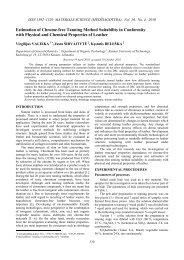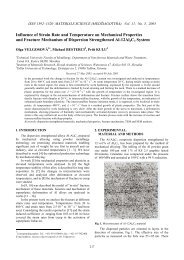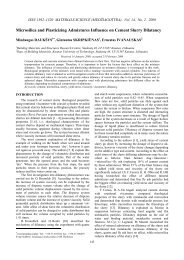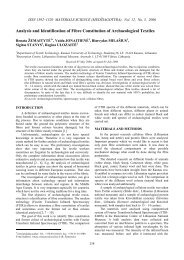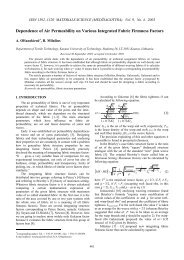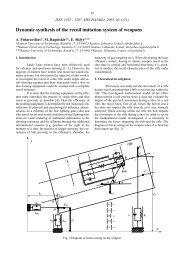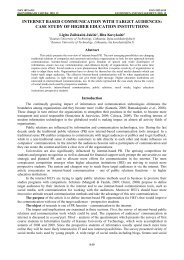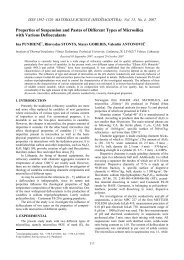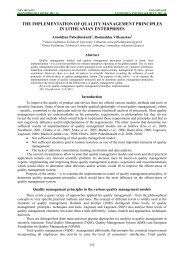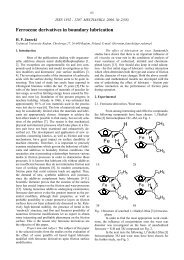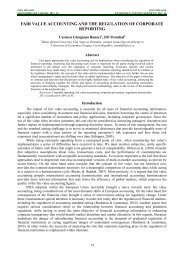Modification of Textile Materials' Surface Properties Using ... - KTU
Modification of Textile Materials' Surface Properties Using ... - KTU
Modification of Textile Materials' Surface Properties Using ... - KTU
You also want an ePaper? Increase the reach of your titles
YUMPU automatically turns print PDFs into web optimized ePapers that Google loves.
ISSN 1392–1320 MATERIALS SCIENCE (MEDŽIAGOTYRA). Vol. 17, No. 1. 2011<br />
<strong>Modification</strong> <strong>of</strong> <strong>Textile</strong> Materials’ <strong>Surface</strong> <strong>Properties</strong> <strong>Using</strong> Chemical S<strong>of</strong>tener<br />
Jurgita KOŽENIAUSKIENĖ ∗ , Virginija DAUKANTIENĖ<br />
Department <strong>of</strong> Clothing and Polymers Products Technologies, Kaunas University <strong>of</strong> Technology,<br />
Studentų 56, LT-51424 Kaunas, Lithuania<br />
Received 09 November 2010; accepted 08 January 2011<br />
In the present study the effect <strong>of</strong> technological treatment involving the processes <strong>of</strong> washing or washing and s<strong>of</strong>tening<br />
with chemical cationic s<strong>of</strong>tener “Surcase” produced in Great Britain on the surface properties <strong>of</strong> cellulosic textile<br />
materials manufactured from cotton, bamboo and viscose spun yarns was investigated. The changes in textile materials<br />
surface properties were evaluated using <strong>KTU</strong>-Griff-Tester device and FEI Quanta 200 FEG scanning electron<br />
microscope (SEM). It was observed that the worst hand properties and the higher surface roughness are observed <strong>of</strong><br />
cotton materials if compared with those <strong>of</strong> bamboo and viscose materials. Also, it was shown that depending on the<br />
material structure the handle parameters <strong>of</strong> knitted materials are the better than the ones <strong>of</strong> woven fabrics.<br />
Keywords: textile, cotton, bamboo, viscose, handle, SEM, washing, s<strong>of</strong>tening.<br />
1. INTRODUCTION ∗<br />
Touch sensation <strong>of</strong> textile material as well as final<br />
garment is defined as textile hand. That property <strong>of</strong> textile<br />
is modified usually during their industrial finishing. <strong>Textile</strong><br />
finishing influences the changes in stiffness as well as in<br />
s<strong>of</strong>tness <strong>of</strong> textile materials increasing tactile comfort<br />
during wear [1]. Additional changes in textile properties<br />
appear during their wearing process after their laundering.<br />
And these changes are very dependent on the mode <strong>of</strong> this<br />
care process, i. e. applying or no chemical liquid s<strong>of</strong>teners<br />
in textile rinsing process. Notwithstanding that cationic<br />
chemical s<strong>of</strong>teners were born in the middle <strong>of</strong> twentieth<br />
century whereas they were not applied widely in textile<br />
care processes up till the end <strong>of</strong> this century [2]. But it is<br />
known that the molecules <strong>of</strong> s<strong>of</strong>tener can be deposited on<br />
fiber surface during defined time that is dependent on the<br />
ionic (cationic) nature <strong>of</strong> s<strong>of</strong>tener molecule as well as on<br />
the level <strong>of</strong> fiber surface hydrophilicy. Every effective<br />
chemical s<strong>of</strong>tener contains a cationic surfactant that<br />
increases the s<strong>of</strong>tness <strong>of</strong> textile material as well as<br />
lubricates its fibers [1, 3]. The changes in textile surface,<br />
mechanical or physical properties after textile materials’<br />
washing as well as after their rinsing in pure water or with<br />
chemical s<strong>of</strong>teners were considered in previous research<br />
works carried out by different scientists [4 – 14]. The great<br />
interest attend on the new generation <strong>of</strong> textile fibers such<br />
as bamboo that still is not deeply investigated, but is<br />
known that the presence <strong>of</strong> this fiber in textile structure<br />
enhances fabric’s hand [4, 15]. Whereas the information<br />
analyzing the properties <strong>of</strong> bamboo fiber treated by<br />
washing and chemical s<strong>of</strong>tening is still very poor. The<br />
published information shows that the applying <strong>of</strong> cationic<br />
s<strong>of</strong>teners in textile products process influences the smaller<br />
or higher changes in their properties that are dependent on<br />
the fiber composition <strong>of</strong> textile material. And, even very<br />
slight changes in textile surface properties can be evaluated<br />
objectively using instrumental methods based on the<br />
∗ Corresponding author. Tel.: +370-672-50345; fax.: +370-37-353989.<br />
E-mail address: jurgita.valiukenaite@stud.ktu.lt (J. Koženiauskienė)<br />
52<br />
extraction <strong>of</strong> a disc-shaped specimen through a central<br />
nozzle [15 – 16].<br />
The aim <strong>of</strong> this research is to estimate the influence <strong>of</strong><br />
washing as well as washing together with s<strong>of</strong>tening using<br />
liquid cationic s<strong>of</strong>tener on the changes in handle<br />
parameters as well as in surface morphology <strong>of</strong> cellulosic<br />
knitted and woven materials manufactured from cotton,<br />
bamboo and viscose spun yarns.<br />
2. MATERIALS AND METHODS<br />
Knitted and woven cellulosic materials manufactured<br />
from cotton, bamboo and viscose spun yarns were<br />
investigated in this research. The structure parameters <strong>of</strong><br />
these materials are presented in Table 1.<br />
The one part <strong>of</strong> samples <strong>of</strong> investigated textile<br />
materials were washed using home washing machine<br />
“Whirpool” at 95 °C washing temperature T and the others<br />
after the same washing process were additionally soaked in<br />
water containing the cationic chemical s<strong>of</strong>tener “Surcase”<br />
(Great Britain) in a laboratory bath for 20 minutes. The<br />
dosage <strong>of</strong> chemical s<strong>of</strong>tener was selected according recommendations<br />
<strong>of</strong> s<strong>of</strong>tener’s producer and was 18 ml per<br />
10 liters <strong>of</strong> water. After technological treatment the<br />
samples were dehumidified in centrifugal dryer with<br />
followed drying in horizontal position. From prepared<br />
material samples the disc-shaped specimens <strong>of</strong> R radius<br />
that was equal to 56.5 mm were cut. Number <strong>of</strong> specimen<br />
in each tested material group varied from 5 to 8. The<br />
coefficient <strong>of</strong> variation varied from 5 % to 8 %.<br />
The effect <strong>of</strong> washing as well as washing together with<br />
s<strong>of</strong>tening using liquid cationic s<strong>of</strong>teners on the ratio <strong>of</strong><br />
textile surface modification should be considered<br />
analyzing textile materials surface properties as well as<br />
their mechanical properties as both affect textile surface<br />
properties, especially their s<strong>of</strong>tness. Mechanical properties<br />
<strong>of</strong> investigated materials were tested using <strong>KTU</strong>-Griff-<br />
Tester device [4, 5, 8, 13] and were estimated from<br />
primary hand parameters such as maximal extracting force<br />
Pmax, tangent tgα <strong>of</strong> the slope angle <strong>of</strong> initial part <strong>of</strong><br />
extracting curve H-P (deformation-force) and extracting
Table 1. Structure parameters <strong>of</strong> investigated textile materials<br />
Material code Composition Weave (knit type)<br />
53<br />
Thickness δ, mm, under<br />
pressure p = 0.5 kPa<br />
<strong>Surface</strong> density, g/m 2<br />
A 01 100 % cotton Plain 0.33 ±0.01 144.4 ±0.4<br />
A 02 100 % bamboo Plain 0.53 ±0.01 218.4 ±1.2<br />
T 03 100 % cotton Plain jersey 0.57 ±0.01 177.1 ±1.2<br />
T 04 100 % bamboo Plain jersey 0.50 ±0.01 176.9 ±1.5<br />
T 05 100 % viscose Plain jersey 0.36 ±0.01 128.4 ±1.7<br />
a<br />
b<br />
Fig. 1. Scheme <strong>of</strong> complex hand Q parameter’s calculation:<br />
a – for woven, b – for knitted materials<br />
work A for woven fabrics and Pmax, tgα, A, specimen H<br />
and changes in materials’ thickness Δδ for knitted materials<br />
as well as from Q complex hand parameter (Fig. 1).<br />
The morphological changes in fabrics’ surface<br />
occurring because <strong>of</strong> different material treatment were<br />
examined using FEI Quanta 200 FEG scanning electron<br />
microscope.<br />
3. RESULTS AND DISCUSSION<br />
The washing and washing together with s<strong>of</strong>tening <strong>of</strong><br />
investigated fabrics increases hand parameters if<br />
compared them to those <strong>of</strong> control (unwashed) textile<br />
materials (Fig. 2). After materials washing without<br />
s<strong>of</strong>tening with chemical liquid s<strong>of</strong>tener the extracting<br />
force Pmax increases from 25 % to 114 %, the tangent tgα<br />
<strong>of</strong> the slope angle <strong>of</strong> initial part <strong>of</strong> extracting curve H-P −<br />
from 2 % to 34 %, the extracting work A − from 48 % to<br />
125 %. The chemical s<strong>of</strong>tening using liquid cationic<br />
s<strong>of</strong>tener decrease the values <strong>of</strong> hand parameters <strong>of</strong><br />
washed and rinsed in pure water textile materials in the<br />
following order: the extracting force Pmax decreases from<br />
1.2 to 1.8 times, the tangent tgα <strong>of</strong> the slope angle <strong>of</strong><br />
initial part <strong>of</strong> extracting curve H-P − from 1.1 to 1.4<br />
times except the ones <strong>of</strong> T03 material that remain almost<br />
unchanged as well as <strong>of</strong> T02 material that increases in 1.2<br />
times, the extracting work A − from 1.1 to 1.7 times and<br />
the complex hand parameter from 1.4 to 9.25 times.<br />
Besides, it was noticed that the complex hand parameter<br />
Q <strong>of</strong> T04 and T05 knitted materials even decreases in<br />
29 % and 17 %, respectively, if compared to those <strong>of</strong><br />
control specimens (Fig. 2, d). Supposedly, the decrease in<br />
handle parameters after textile s<strong>of</strong>tening appeared<br />
because <strong>of</strong> increased material s<strong>of</strong>tness and surface<br />
smoothness.<br />
The maximal changes in Pmax, tgα, A and Q handle<br />
parameters were determined for A01 cotton woven fabric<br />
excluding the changes in tangent tgα <strong>of</strong> slope angle <strong>of</strong><br />
initial part <strong>of</strong> extracting curve H-P for A02 bamboo<br />
woven fabric as well as changes in Q complex handle<br />
parameter <strong>of</strong> T05 viscose knitted material. The highest<br />
changes in hand parameters <strong>of</strong> treated viscose knitted<br />
material were observed if compared it to others knitted<br />
materials, supposedly because <strong>of</strong> higher susceptibility <strong>of</strong><br />
viscose fibers to treatment processes than most other<br />
fibers as they have lower crystallinity index than other<br />
regenerated cellulose and cotton-based fabric, i. e. 50 % –<br />
60 % amorphous regions are accessible to physicochemical<br />
interactions while they are 20 % for cotton<br />
[17, 18]. The opposite tendencies were determined for<br />
A02 bamboo fabric exhibiting the increase in Pmax<br />
extracting force after its washing and s<strong>of</strong>tening. It means<br />
that after such type <strong>of</strong> textile treatment it became rougher.<br />
After s<strong>of</strong>tening Q complex parameter <strong>of</strong> A01 woven<br />
fabric decreased in 9.3 times as well as one <strong>of</strong> T05<br />
knitted fabric decreased in 8.2 times if compared to<br />
rinsed in pure water materials. The primary parameters <strong>of</strong><br />
knitted materials’ extracting through a nozzle are lower<br />
than ones <strong>of</strong> woven fabric because <strong>of</strong> looser structure <strong>of</strong><br />
knitted materials that influences the higher structure<br />
mobility and s<strong>of</strong>tness.<br />
So, it was proven that cationic s<strong>of</strong>tener “Surcase”<br />
could improve textile hand if compared with washed<br />
materials as well as with control materials’ specimens.<br />
So, the usage <strong>of</strong> rinse cycle liquid cationic s<strong>of</strong>teners<br />
substantially qualifies reduction <strong>of</strong> hand rates [7 – 8].<br />
The comparison analysis <strong>of</strong> surface morphology <strong>of</strong><br />
investigated fabrics has shown the presence <strong>of</strong><br />
differences between washed materials (Fig. 3, a–c) and<br />
washed and rinsed with chemical s<strong>of</strong>teners materials<br />
(Fig. 3, d, e and f). The prominent flutes oriented towards<br />
fiber longitudinal axis are observed on the surface <strong>of</strong><br />
washed materials.
Pmax, , N<br />
A, N·cm 400<br />
350<br />
300<br />
250<br />
200<br />
150<br />
100<br />
50<br />
0<br />
10<br />
9<br />
8<br />
7<br />
6<br />
5<br />
4<br />
3<br />
2<br />
1<br />
0<br />
189.7<br />
45.6<br />
335.6<br />
87.0<br />
61.1<br />
23.6<br />
29.6<br />
35.4<br />
6.0<br />
8.7<br />
7.1<br />
6.3<br />
10.3<br />
7.9<br />
8.1<br />
17.4<br />
9.6<br />
A01 A02 T03 T04 T05<br />
239.4<br />
84.0<br />
132.4<br />
120.7<br />
54<br />
tgα<br />
10<br />
8<br />
6<br />
4<br />
2<br />
0<br />
6.493<br />
8.651<br />
6.811<br />
9.183<br />
9.369<br />
8.663<br />
3.006<br />
3.691<br />
3.672<br />
3.304<br />
4.219<br />
3.775<br />
1.725<br />
2.306<br />
1.658<br />
A01 A02 T03 T04 T05<br />
a b<br />
17.8<br />
26.4<br />
20.8<br />
21.3<br />
38.8<br />
29.8<br />
24.7<br />
55.6<br />
32.1<br />
A01 A02 T03 T04 T05<br />
0.45<br />
0.40<br />
0.35<br />
0.30<br />
0.25<br />
0.20<br />
0.15<br />
0.10<br />
0.05<br />
0<br />
0.001<br />
0.37<br />
0.04<br />
0.01<br />
0.37<br />
0.17<br />
0.16<br />
0.30<br />
0.22<br />
0.14<br />
0.34<br />
0.10<br />
0.06<br />
0.41<br />
A01 A02 T03 T04 T05<br />
c d<br />
Fig. 2. The hand parameters P max (a), tgα (b), A (c) and Q (d) <strong>of</strong> washed and washed with followed chemical s<strong>of</strong>tening <strong>of</strong> woven fabrics<br />
A01, A02 and knitted materials T03,T04 and T05: – control, ■ – washed, ■ – washed+s<strong>of</strong>tened<br />
a b c<br />
d e f<br />
Fig. 3. <strong>Surface</strong> morphology <strong>of</strong> cotton A01 (a, d), bamboo T04 (b, e) and viscose T05 (c, f) textile materials after washing (a, b, c) and<br />
washing together with s<strong>of</strong>tening (d, e, f)<br />
Q<br />
0.05
If compared among themselves all washed cotton,<br />
bamboo and viscose textile materials, it can be seen that<br />
the surface <strong>of</strong> viscose material is the smoothest (Fig. 3, c).<br />
The chemical s<strong>of</strong>tening evidently increases the smoothness<br />
<strong>of</strong> all investigated materials, especially <strong>of</strong> bamboo material<br />
(Fig. 3, e) that before s<strong>of</strong>tening displayed a tubular and<br />
ribbed longitudinal surface (Fig. 3, b). The increased<br />
smoothness <strong>of</strong> bamboo material’s surface after s<strong>of</strong>tening<br />
process could be influenced by its structure that is relevant<br />
to amorphous and leads superior hygroscopicity [9].<br />
4. CONCLUSIONS<br />
1. It was proven that the washing and washing together<br />
with s<strong>of</strong>tening <strong>of</strong> cellulosic woven and knitted<br />
materials increases the primary hand parameters <strong>of</strong><br />
control (unwashed) materials. And, if compared<br />
treated materials among them it can be seen, that<br />
determined increase is lower for fabrics s<strong>of</strong>tened with<br />
cationic s<strong>of</strong>tener “Surcase”. It was observed<br />
additionally, that the complex hand parameter Q <strong>of</strong><br />
T04 and T05 knitted materials even decreases if<br />
compared with those <strong>of</strong> control specimens.<br />
2. Based on the results obtained, it was found that the<br />
worst hand property have cotton woven fabric if<br />
compared them to bamboo and viscose materials.<br />
3. The presented investigation confirmed that the values<br />
<strong>of</strong> primary hand parameters Pmax, tgα and A <strong>of</strong> knitted<br />
materials are the lower than <strong>of</strong> woven materials.<br />
4. The comparison analysis <strong>of</strong> surface morphology <strong>of</strong><br />
investigated materials has shown that chemical<br />
s<strong>of</strong>tening significantly increases their surface<br />
smoothness.<br />
REFERENCES<br />
1. Wang, J., Liu, J. <strong>Surface</strong> <strong>Modification</strong> <strong>of</strong> <strong>Textile</strong>s by<br />
Aqueous Solutions <strong>Surface</strong> <strong>Modification</strong> <strong>of</strong> <strong>Textile</strong>s The<br />
<strong>Textile</strong> Institute, Woodhead Publishing in <strong>Textile</strong>s, 2009:<br />
pp. 269 – 295.<br />
2. Dubrow, P. L., Linfield, W. M. Cationic <strong>Textile</strong> S<strong>of</strong>teners<br />
for Home Fabric S<strong>of</strong>teners Soap and Chemical Specialties<br />
33 1957: pp. 89 – 97.<br />
3. Schindler, W. D., Hauser, P. J. Chemical Finishing <strong>of</strong><br />
<strong>Textile</strong>s S<strong>of</strong>tening Finishes The <strong>Textile</strong> Institute,<br />
Woodhead Publishing Limited, Cambridge, England, 2004:<br />
pp. 29 – 42.<br />
4. Grinevičiūtė, D., Kazakevičiūtė, G., Gutauskas, M.,<br />
5.<br />
Rimkutė, R., Abraitienė, A. Influence <strong>of</strong> Bamboo Fiber on<br />
Fabric Hand Proceedings <strong>of</strong> Baltic Polymer Symposium<br />
September 19 – 21, 2007, Druskininkai, Lithuania Vilnius<br />
University, Kaunas University <strong>of</strong> Technology. Vilnius:<br />
Vilnius University, 2007: pp. 176 – 180.<br />
Daukantienė, V., Zmailaitė, E., Gutauskas, M. Influence<br />
<strong>of</strong> Concentrated Liquid S<strong>of</strong>teners on <strong>Textile</strong> Hand Indian<br />
Journal <strong>of</strong> Fibre and <strong>Textile</strong> Research ISSN 0971-0426 30<br />
2005: pp. 200 – 203.<br />
55<br />
6. Truncytė, D., Gutauskas, M. The Influence <strong>of</strong> the<br />
Technological Treatment Regime on the Mechanical<br />
<strong>Properties</strong> <strong>of</strong> <strong>Textile</strong> Fabrics Materials Science<br />
(Medžiagotyra) 12 (4) 2006: pp. 350 – 354.<br />
7. Juodsnukytė, D., Gutauskas, M., Kraulėdas, S. Influence<br />
<strong>of</strong> Fabric S<strong>of</strong>teners on Performance Stability <strong>of</strong> the <strong>Textile</strong><br />
Materials Materials Science (Medžiagotyra) 11 (2) 2005:<br />
pp. 179 – 182.<br />
8. Juodsnukytė, D., Daukantienė, V., Abraitienė, A.,<br />
Gutauskas, M. Influence <strong>of</strong> Washing and Liquid S<strong>of</strong>teners<br />
on the Change <strong>of</strong> Knitted Fabrics Hand Tekstil 54 (3)<br />
2005: pp. 99 – 103.<br />
9. Grinevičiūtė, D., Stankutė, R., Gutauskas, M.,<br />
Abraitienė, A., Baltušnikas, A., Baltakys, K. Influence <strong>of</strong><br />
New Fiber-forming Polymers Structure on Garment Hand<br />
Parameters Materials Science (Medžiagotyra) 16 (2)<br />
2010: pp. 144 – 147.<br />
10. Linfield, W. M., Sherrill, J. C., Davis, G. A., Raschke,<br />
R. M. Fabric Treatment with Cationic S<strong>of</strong>teners Journal <strong>of</strong><br />
the American Oil Chemists‘ Society 35 (11) 1958:<br />
pp. 590 – 593.<br />
11. Parvinzadeh, M., Memari, N., Shaver, M., Katozian, B.,<br />
Ahmadi, S., Ziadi, I. Influence <strong>of</strong> Ultrasonic Waves on the<br />
Processing <strong>of</strong> Cotton with Cationic S<strong>of</strong>tener Journal <strong>of</strong><br />
Surfactants and Detergents 13 (2) 2010: pp. 135 – 141.<br />
12. Oberdorf, S. K., Dixit, V., Woo, D. J. Microscopy Study <strong>of</strong><br />
Distribution <strong>of</strong> Laundry Fabric S<strong>of</strong>tener on Cotton Fabric<br />
Journal <strong>of</strong> Surfactants and Detergents 12 2009:<br />
pp. 225 – 230.<br />
13. Shakyawar, D. B., Behera, B. K. Influence <strong>of</strong> S<strong>of</strong>tening<br />
Treatments on Hand Value <strong>of</strong> Woven Fabrics Produced from<br />
Indian Wool and Their Blends Indian Journal <strong>of</strong> Fibre and<br />
<strong>Textile</strong> Research 34 2009: pp. 76 – 81.<br />
14. Grinevičiūtė, D., Kazakevičiūtė, G., Abraitienė, A.,<br />
Truncytė, D., Gutauskas, M. Control <strong>of</strong> Fabric End Use<br />
<strong>Properties</strong> Based on the Principle <strong>of</strong> Restricted Pulling<br />
Through a Nozzle Materials Science (Medžiagotyra)<br />
13 (4) 2007: pp. 343 – 345.<br />
15. Waite, M., Platts, J. Engineering Sustainable <strong>Textile</strong>s: a<br />
Bamboo <strong>Textile</strong> Comparison Energy, Environment,<br />
Ecosystems, Development and Lanscape Architecture<br />
pp. 362 – 368 (www.wseas.us/e-library/conferences/2009/...<br />
/EELA-58.pdf)<br />
16. Valiukėnaitė, J., Grinevičiūtė, D., Abraitienė, A.,<br />
Gutauskas, M. Analysis <strong>of</strong> New Fiber-Forming Polymers'<br />
<strong>Surface</strong> <strong>Properties</strong> Mechanika: Proceedings <strong>of</strong> the 14th<br />
International Conference 2009: pp. 421 – 425.<br />
17. Lukanova, V., Ganchev, V. A Possibility for Shrinkage<br />
Decrease <strong>of</strong> <strong>Textile</strong> Fabrics Made from Cotton and Viscose<br />
Fibers Fibres & <strong>Textile</strong>s in Eastern Europe 13 (1) 2005:<br />
pp. 51 – 53.<br />
18. Özgüney, A. T., Tarakçioğlu, I., Körlü, A. E., Özerdem,<br />
A., Bahtiyari, M. I. Effects <strong>of</strong> Different Pretreatment<br />
Processes on Viscose Fabrics in Different Types and<br />
<strong>Properties</strong> Journal <strong>of</strong> <strong>Textile</strong> Institute 96 (5) 2005:<br />
pp. 319 – 327.<br />
Presented at the National Conference "Materials Engineering’2010"<br />
(Kaunas, Lithuania, November 19, 2010)



